From the Equipment Corner: Wokology 101
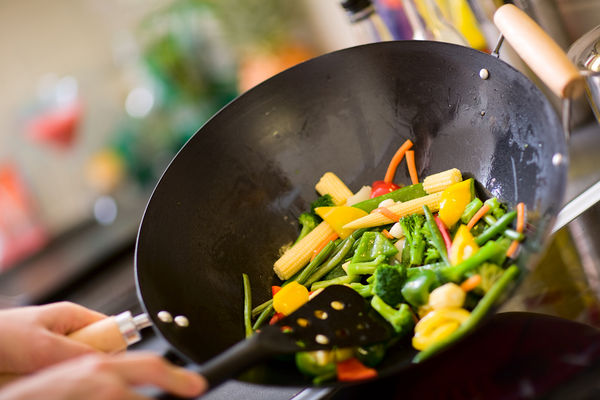
A good wok is one of the most versatile pans in the kitchen. Beyond being the best choice for a stir fry, did you know it’s also the ideal vessel for deep-frying, steaming, and indoor smoking? It’s the most commonly used pan in most professional chefs’ kitchens, as a matter of fact.
But as with most things, not all woks are created equal. They come in a mind-boggling array of sizes, shapes, metals, and handle arrangements. Fortunately for all of us, the best woks also happen to be on the inexpensive end of the scale.
Here are some things to consider when purchasing one, according to the testers at one of my favorite sites, Serious Eats (www.seriouseates.com). I’ll quote them:
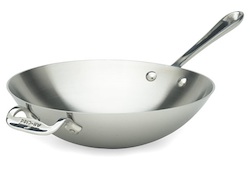
First let’s consider materials. “Stainless steel is always a great material for cooking, but in this case, it makes the wok extremely heavy and difficult to maneuver. And this material also takes a long time to heat up and cool down—a fatal flaw for something that requires rapid, on-the-fly heat adjustments like stir fry. Also, food, especially protein, has a tendency to stick to stainless steel.
“Cast iron is a better choice, though is still takes a relatively long time to heat up and cool down. While it offers a better nonstick surface, the problem with cast iron is that when it’s too thin, it’s very fragile. They’ve been known to crack in half when set down too hard. And of course, when they’re made thick enough to be durable, like stainless steel, they’re cumbersome to lift.
“Carbon steel is the best bet. It heats quickly and evenly, is highly responsive to burner input, is durable, inexpensive, and when properly cared for, will end up with a practically nonstick surface. You want a carbon steel wok that’s at least 14-guage (about 2mm thick).”
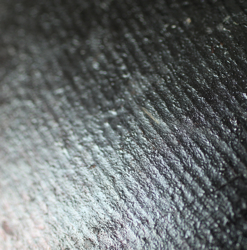
Now how they’re made: “Woks are made in three ways. Traditional hand hammered woks are an excellent choice. The slight indentations left by the hammering pattern allow you to push cooked food to the sides of the pan while adding ingredients to the center without them slipping. The only problem is that it can be difficult (impossible?) to find a hand-hammered wok with a flat bottom and a handle.
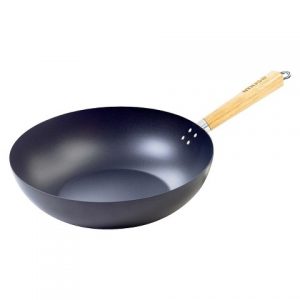
“Stamped woks are made by cutting out a circular piece of thin carbon steel and pressing it by machine into a mold. While they’re inexpensive (very cheap), they are completely smooth, making them difficult to stir-fry properly. Without fail they’re made from low-gauge steel and develop hot spots. They’re flimsy, so avoid this type of wok.
“Spun woks are made on a lathe, giving them a distinct pattern of concentric circles. This pattern offers the same advantages as a hand-hammered wok when keeping food in place against the pan sides. These can be found in heavy gauges, with flat bottoms and flip-friendly handles. This is also another inexpensive pan.”
Shape is the next consideration: “Traditional woks have a deep bowl shape. These are tough to work with; they won’t work, period, on an electric range, and are tough to use on a gas range (even with one of those wok rings). On the other hand, woks with bottoms that are too flat defeat the purpose of a wok, making it tough to flip properly and to move food in and out of the high-heat zone.
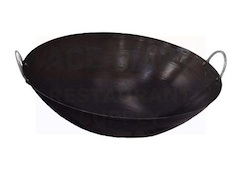
”Your best bet? A wok with a 4- to 5-inch flattened area at the bottom with gently sloping sides that flare out to between 12 and 14 inches. This will give you plenty of high-heat space for searing meats and vegetables at the bottom while still providing ample volume and room to maneuver when flipping.”
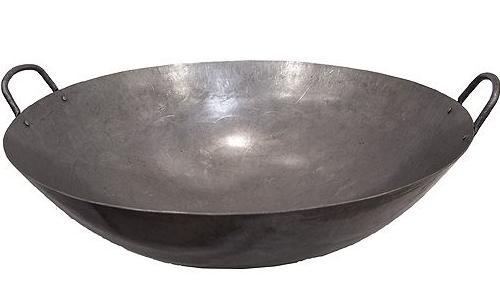
Handles need consideration as well: “…you have two choices. Cantonese-style woks (pictured in inset above) have two small handles on either side You don’t want this type. They’re hard to use. The Northern-style woks have a single long handle and usually a smaller helper-handle on the opposite side. This is the type of wok you want. The large handle facilitates flipping and stir-frying, while the short handle makes it easy to lift.

“Finally, avoid nonstick woks at all costs. Most cannot handle the high heat necessary for a proper stir-fry. They start releasing noxious fumes long before they reach the requisite temperature. They make browning difficult, and it’s impossible to get food to stick in place against the sides when you want to clear a surface to cook in the middle.”
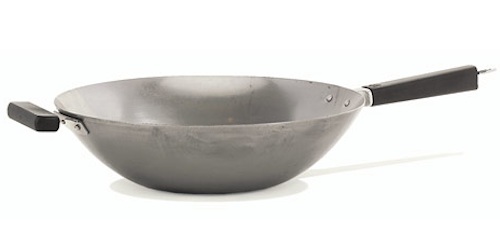
So all this said, which wok does Serious Eats recommend? While there are several woks that match the above criteria, the Joyce Chen 21-9978, Classic Series 14 Inch Carbon Steel Wok ($29.95) is the favorite. It features heavy gauge carbon steel, a riveted heat-resistant phenolic-plastic Northern-style handle with a helper handle, and is extremely inexpensive. A big relief, considering how expensive good cookware can be!
- www.childrenscornerbk.com
- www.seriouseats.co
- www.wagshalsblog.com
- www.thoroughlyreviewed.com
 Alice Osborne
Alice Osborne
Weekly Newsletter Contributor since 2006
Email the author! alice@dvo.com
